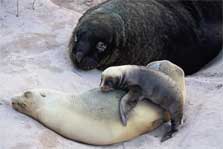Assessing the demographic parameters and at sea distribution of NZ sea lions, Auckland Islands 2007/08-2009/10
Published:
December 2010Download the publication

New Zealand sea lion male, female and pup, Enderby Island, Auckland Islands
Summary
The New Zealand sea lion (NZ sea lion), Phocarctos hookeri, is New Zealand’s only endemic pinniped. It is classified as Nationally Critical and is estimated to be the world’s rarest sea lion. This report summaries three annual surveys (2007-08, 2008-09, 2009-10) of the Auckland Island area with the objective to collect data to allow quantification and estimation of demographic parameters of NZ sea lions and the at-sea distribution of juvenile NZ sea lions from the Auckland Islands.
The pup production estimates for the Auckland Islands NZ sea lion population declined by 18.4% during the three year period with the most significant change recorded being a 31% decrease in pup production at the Auckland Islands between 2007-08 and 2008-09.
Field sightings of previously tagged, branded and/or passive integrated transponder (PIT) tagged animals were collected and recorded. The NZ sea lion database has had the three field seasons data entered, checked and data extraction has occurred to allow for the estimation of survival of previously marked NZ sea lions and reproduction by known age female NZ sea lions.
The at sea distribution of both male and female juvenile NZ sea lions from the Sandy Bay breeding site were investigated during the three seasons. Fifteen females aged two and three years of age and 11 males aged between two and five years of age were captured and satellite tags were attached for between 2 and 71 days. Overall, the majority of juvenile NZ sea lions (those four years old and less) showed foraging distributions close to the Auckland Islands on the Auckland Island shelf, predominantly in the North and North-east areas of the shelf. There was significant overlap between juvenile NZ sea lion foraging locations and arrow squid (Nototodarus sloanii) 6T fisheries activities which is likely to result in fisheries/juvenile sea lion interactions and deaths, as does occur. For Sandy Bay juvenile NZ sea lions, there was little overlap of foraging locations with scampi or other fisheries activities around the Auckland Island area.
Publication information
Author: Dr. B.Louise Chilvers
Contact
Conservation Services Programme
Department of Conservation
PO Box 10-420
Wellington 6143
Email: csp@doc.govt.nz
